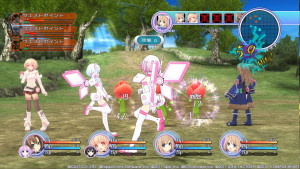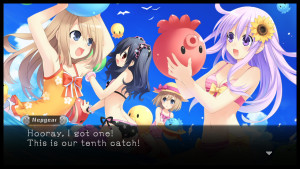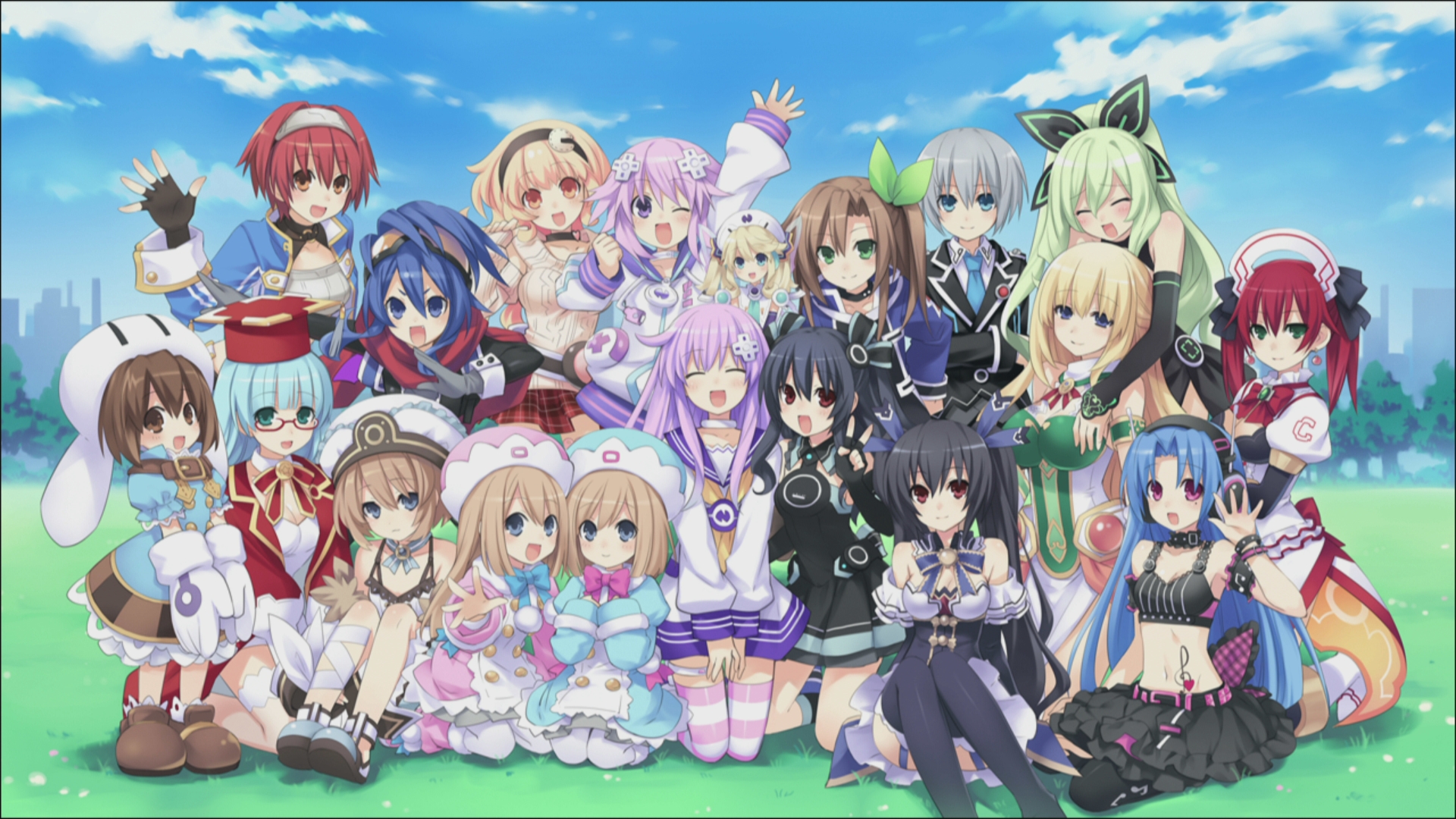More focus, budget, bigger scale, and more involved than before – all of these words and phrases describe the transition between the original Hyperdimension Neptunia and Mk2 quite well. It’s been more than a year since I imparted my thoughts on the widely panned original – but how does the highly awaited, jointly developed by Comcept sequel play out?
Quite well. For those of you who were turned off by the original game’s rougher around the edges areas (Tedious battle system, poor graphic, performance issues, etc.), I can safely assure you that about 75% of those issues have been dealt with. Let’s get into the nitty gritty, shall we?
The story begins with Neptune, Noire, Blanc, and Vert having been captured by a syndicate dedicated to reviving the evil goddess Arfoire. Because their shares have grown so low, they’ve become unable to fight back as the syndicate keeps them captive in the CPU graveyard. In the limelight this time around is Neptune’s sister Nepgear (Who’s birth into existence is actually detailed in the first game’s remake, rebirth!) I.F. and Compa, unable to defeat the powerful CFW Magic and release Neptune and the other goddesses, retreat and work with Nepgear on turning the world against the CFW in order to save their friends.
 For those of you that recall the first game’s true ending, you may be wondering “How could a sequel to this game ever be made?” Good question – with the goddesses having renounced their “godship”, what else is there to do? That’s easy – a retcon. While technically Mk2 takes place in a different universe than the first game, the game’s narrative and prologue lead me to believe it’s more “Pretend we retconned these things from the first game” than “This game has no relation to the first game at all!” What leads me to believe this? A few items.
For those of you that recall the first game’s true ending, you may be wondering “How could a sequel to this game ever be made?” Good question – with the goddesses having renounced their “godship”, what else is there to do? That’s easy – a retcon. While technically Mk2 takes place in a different universe than the first game, the game’s narrative and prologue lead me to believe it’s more “Pretend we retconned these things from the first game” than “This game has no relation to the first game at all!” What leads me to believe this? A few items.
- The Console War and the battle with Arfoire is laid out as the ground work for the game’s current conflict – The battles of the previously bickering and not-quite-so-friendly CPU’s is recounted, including how they put their differences aside and worked together in the true ending to defeat a greater evil.
- Character development and growth that occurred in the previous game seems to still be present – Characters that nurtured a relationship or feelings for one another retain those feelings in this game, most noticeably between I.F., Compa, and Neptune.
- Despite some aesthetic changes, the world is identical – Yes, we still have Planeptune, Lastation, Lowee, and Leanbox. They keep their aesthetics (although they’re no longer floating islands).
So what changed that technically makes this take place in a different universe/a retcon? Compa and Iffy are “Childhood friends”, the goddesses never renounced their powers (Retained godship at the end of the previous game), and that’s about it. Otherwise, this is a sequel, don’t listen to Idea Factory.
How about the gameplay? As is standard for the series, story events are divided up by small scenes, voiced or unvoiced, except that the interface and general feel of the game has been so starkly improved you may not even recognize it anymore. All the menu’s are crisp and easy to navigate, including the main menu. Good thing because you’ll be seeing it a lot as the game progresses onward! “Story flags” or rather, those events you need to see in order to progress the story onward, are clearly marked and easily denoted by event icons. So far, so good.
Dungeons are a huge improvement. Random encounters are gone and the battle system has been completely revamped. While I miss the cool, stylish perspective of the first game’s battle system I cannot deny that this is an almost objective improvement. Rather than each character having several actions and movements per battle (With ‘link’ operations performed after each full combo), characters move on a three dimensional battle space with turn based combat. Basically – you move, use an item, attack, defend, transform, or use a skill. Often times you will find that you can strike several enemies at once, which is quite nice. I particularly spend a lot of time finagling until I hit more enemies than I probably should be able to. Don’t worry – just because the battle system has changed doesn’t meant that the highly stylish, over the top skills are gone. They’re here in full force (Say hello to Cave!)
Also notable is that with the addition of the new battle system (Which is further tweaked and standardized in the sequel to this game), characters gain their staple trademark attacks and moves that stay with them for the series duration at this point. For example, Noire’s Lace Ribbon, Drop Crush, Tricolor order. Neptune’s Dual edge, Variable edge, cross combination. IF’s Demon Flames, LeDelphinus, etc. You get the idea. The point to take away here is that the Neptunia series is establishing itself as a franchise with some staying power.
The story is the darkest in the series to date and, in my opinion, the best. ASIC has essentially taken over Gamindustri and you must see a fledgling, scared, but resolute Nepgear to the finish. Just like you might expect, she’s not all buddy-buddy with the other candidates at first, either. Oh, what a “CPU Candidate”, you ask? That is the term used to describe the “Sisters” to the CPU’s, based on the handhelds of their country of origin. Obviously, Vert does not have one, and Blanc has two!
 Nisa and Gust are finally worked officially into the story. Their appearances will make you smile. ASIC feels truly intimidating and it feels as though your task is insurmountable. While Nepgear is really the main character, if it wasn’t for IF I doubt anything would get done – she’s the true leader, driven and focused. There are several new characters, including Linda (frequently called underling by the heroes), who is my favorite. Will she return to the series? I hope so.
Nisa and Gust are finally worked officially into the story. Their appearances will make you smile. ASIC feels truly intimidating and it feels as though your task is insurmountable. While Nepgear is really the main character, if it wasn’t for IF I doubt anything would get done – she’s the true leader, driven and focused. There are several new characters, including Linda (frequently called underling by the heroes), who is my favorite. Will she return to the series? I hope so.
Also included are the oracles of every landmass – think of them like a ‘head secretary’. Histoire, now no longer trapped and residing in Planeptune, is obviously a shoe-in for Planeptune’s oracle, with Kei, Mina, and Chika taking up the other lands. As was the case for the first game, the story is segregated into several “Complete thoughts”, which is great for the story’s digestion. Early on we are introduced to Linda, dubbed as “underling” by IF, who is essentially ASIC’s main helper-hand. IF recognizes her for the cannon fodder she is meant to be and thereby dubs her so. The thing is that early game, Linda is quite powerful – she almost destroys us. Thankfully, Nepgear learns to transform and forces her to retreat. As time goes on, Underling grows less and less imposing to the point that they mention to they do need to even go into “A boss scene” with her, and instead defeat her in the cutscene. Pretty humurous, all things considered. Neptune usually handles power creeps with grace.
Underling isn’t the only one they need to worry about – there are four judges that precide over ASIC, including Justice, Brave, Trick, and Magic. Brave goes down pretty easily, but Justice and Trick hang around for quite some time. Justice and Uni even have an interesting spat concerning pirating, and while it’s nothing new the commentary on the flashcart industry is interesting to note and personally one of my favorite moments in the entire game.
Slightly unrelated – beware of the battle with Nepgear and Uni vs Justice – it is easily the most difficult battle in the game.
The perspective is interesting – without Neptune as a protagonist, things progress very differently. What does gameindustri look like without Neptune? Hell, what does it look like without the goddesses? The result is a more intimidating, unknown world than previously presented, with IF and to a lesser extent Compa taking a mentor role to the fledgling Nepgear. Nepgear is forced to come to terms with her inexperience, along the way meeting the oracles and candidates of other nations with whom she doesn’t necessarily get along with initially.
I think that we can agree that in a heavily character driven RPG, your protagonist frames the narrative and your perception of the game’s world and story. Nepgear isn’t like Neptune at all – she’s responsible, thoughtful, careful, and resolute. Some claim that because of these ordinary qualities she makes a boring protagonist, but I disagree; by association of those around her, she shines quite brightly. Think of it this way – perhaps in a vacuum those qualities would fail to be interesting to most, but when contrasted with her allies, it makes things quite different.
The story progresses in a satisfying manner – the moment where you rescue the CPU’s in the CPU graveyard near the end of the game feels like the game’s “Ocean palace” event. After temporarily defeating those who stand in your way and freeing the CPU’s, it feels as though the story has really opened up – your party is huge and you have everyone at your disposal and on your side. You feel powerful, but the game still manages to loom an even greater darkness upon you.
Let’s put aside the story for a moment. The music has definitely improved. While I love the tunes of the first game, they no doubt suffered from a minimal budget. For whatever reason Idea Factory discards the first game’s OST for the remainder of the series and pretends it doesn’t exist ever again. Get used to mk2’s tunes, as you will hear them aplenty in Victory and all rebirth games. Is that a band thing? Certainly not, as there are several great themes – Solid Park (Normal battle theme), ASIC battle, World map theme, etc. Dynamic and more cheerful than the original, these themes also are consistent with establishing the series as a respected franchise.
 I doubt you’ve read a single thing about this game that hasn’t mentioned the infamous conquest ending – while obviously not canon it is easily the darkest element in the series history to date. I won’t spoil it, but be prepared for some emotional twists and turns as well as some betrayals.
I doubt you’ve read a single thing about this game that hasn’t mentioned the infamous conquest ending – while obviously not canon it is easily the darkest element in the series history to date. I won’t spoil it, but be prepared for some emotional twists and turns as well as some betrayals.
There are some problems, of course. The framerate still suffers massively in certain locations (Although performance is better overall). Despite the games better looks over the first game, frame rate issues have plagued the series, even to date. I think it could benefit greatly from running in 720p rather than a full 1080p. Could also use some anti-aliasing, but at that point I’m nitpicking a bit.
I wish the dungeons were more interesting – often times you’ll just be wandering around a plain field or factory with little of note. While the prospect of getting to the next story event is enticing, it would be far better if the dungeons had some puzzles or variety to them. More egregious is that dungeons are sometimes copy-pasted in the series – to be fair, they are the same locations between games so it makes sense, but I’d still love to see some real dungeons from the series.
No idea why they decided to go with 3d models in the cutscenes rather than the beautiful 2d portraits used in the first game. Thankfully, this is a decision that is never revisited in the series as in Victory they go right back to where they were. Trust me, for this we are grateful.
Also a nitpick, but goddess forms have received a serious nerf. To maintain your CPU form takes some serious SP, as it drains it every turn. You need to dedicate certain characters to just stuffing your CPU characters with SP chargers, which can get annoying. Again though, thankfully this is fixed in future installments like Victory or the rebirth trilogy.
Overall, what do I give HDN Mk2? It might surprise you, but I’d give it a solid 9 if I had to score out of 10. It has faults, it’s not perfect – but it has improved so exponentially on all aspects present in the first game and written with such dark twists and turns. Worth a play, and even though many may disagree, I’d still recommend you play the first outing before beginning this one. While this series isn’t for everyone, I think you owe the greatest Neptune game a cursory glance.






